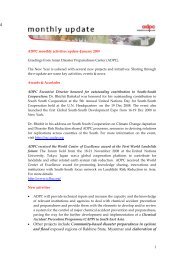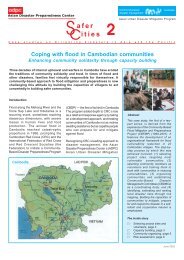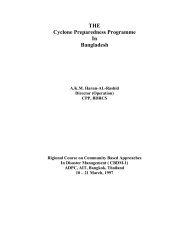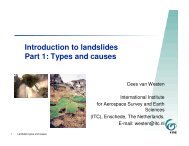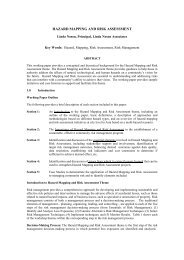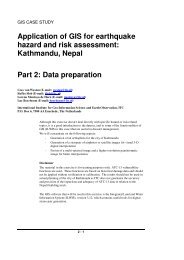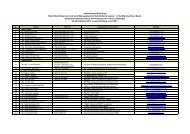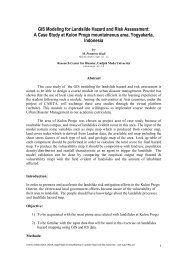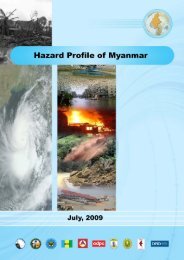community-based disaster risk management and the media media kit
community-based disaster risk management and the media media kit
community-based disaster risk management and the media media kit
You also want an ePaper? Increase the reach of your titles
YUMPU automatically turns print PDFs into web optimized ePapers that Google loves.
Community-<strong>based</strong> TYPHOON<br />
Preparedness<br />
chapter 3. useful information for <strong>the</strong> <strong>media</strong><br />
A TYPHOON is an intense tropical disturbance characterized by a low<br />
pressure area at <strong>the</strong> center. In <strong>the</strong> Nor<strong>the</strong>rn Hemisphere, as a result<br />
of <strong>the</strong> earth’s rotation about its side, <strong>the</strong> wind blows counterclockwise<br />
around <strong>the</strong> center of a low pressure area, <strong>and</strong> in <strong>the</strong> Sou<strong>the</strong>rn<br />
Hemisphere, <strong>the</strong> wind blows clockwise. The typhoon is <strong>the</strong> strongest of<br />
a class of wea<strong>the</strong>r disturbances called tropical cyclones.<br />
Formation of Typhoon<br />
• Warm, moist air above <strong>the</strong> sea rises quickly to <strong>the</strong> cooler high<br />
altitudes causing a very low pressure area <strong>and</strong> formation of cumulus<br />
nimbus clouds.<br />
• Surrounding air at <strong>the</strong> sea surface moves in to take <strong>the</strong> place of <strong>the</strong><br />
rising air. Rotational forces of <strong>the</strong> earth result in a circular motion<br />
of <strong>the</strong> winds <strong>and</strong> cloud formations around <strong>the</strong> central low-pressure<br />
area. The motion is clockwise in <strong>the</strong> South Pacifi c.<br />
• Colder air is drawn slowly to <strong>the</strong> center of <strong>the</strong> system forming <strong>the</strong><br />
eye of <strong>the</strong> storm.<br />
• Winds close to <strong>the</strong> eye become very strong (hurricane force).<br />
• Entire cyclone systems are moved along by <strong>the</strong> trade winds at<br />
speeds of between 10-25 km per hour.<br />
The Eye of <strong>the</strong> Typhoon<br />
The “eye” of a typhoon is a small central area of some 10 to 50 kilometers<br />
in diameter. It is characterized by relatively calm or light winds, clear to<br />
partly cloudy skies, high humidity, warm temperatures, <strong>and</strong> usually fi ne<br />
wea<strong>the</strong>r.<br />
Classifi cations of Tropical Cyclones<br />
Tropical cyclones are classifi ed according to <strong>the</strong> strength of <strong>the</strong><br />
accompanying winds. The three categories into which tropical cyclones<br />
fall are:<br />
• Tropical Depression. Maximum wind speed near <strong>the</strong> center is less<br />
than 63 kilometers per hour<br />
• Tropical Storm. Maximum wind speed near <strong>the</strong> center ranges from<br />
63 to 118 kilometers per hour<br />
71



